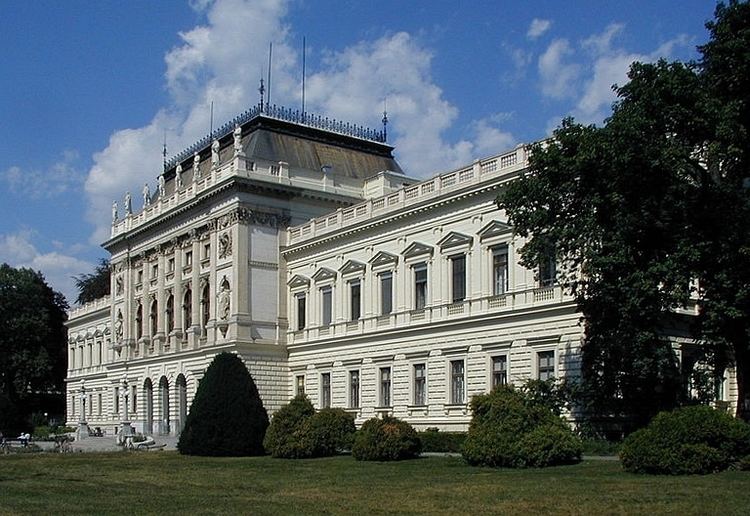Motto Numquam retro Affiliation non-denominational Undergraduate tuition and fees 726.72 EUR (2011) Phone +43 316 3800 Rector Christa Neuper | Motto in English Never back! (Latin) Established 1585 Academic staff 2,676 Total enrollment 30,000 (2010) Founded 1585 Endowment 189.3 million EUR | |
 | ||
Notable alumni Similar Graz University of Techno, University of Vienna, Medical University of Graz, University of Innsbruck, University of Music and Perfo Profiles | ||
The University of Graz (German: Karl-Franzens-Universität Graz), located in Graz, Austria, is the largest and oldest university in Styria, as well as the second-largest and second-oldest university in Austria.
Contents
- University of graz austria
- International acclaim
- Religious affiliation
- Nobel prize laureates
- Other well known professors
- Famous alumni
- Further studies
- References
Karl-Franzens-Universität, also referred to as the University of Graz, is the city's oldest university, founded in 1585 by Archduke Charles II of Austria. With bull of 1 January 1586, edited on 15 April 1586, was approved from Pope Sixtus V For most of its existence it was controlled by the Catholic Church, and was closed in 1782 by Emperor Joseph II in an attempt to gain state control over educational institutions. Joseph II transformed it into a lyceum where civil servants and medical personnel were trained. In 1827 it was re-instituted as a university by Emperor Francis I, thus gaining the name Karl-Franzens-Universität, meaning Charles Francis University. Over 30,000 students are currently enrolled at this university.
The university is sub-divided into six different faculties, the two largest ones being the Faculty of Arts and Humanities and Faculty of Natural Sciences. The other faculties are the faculties of Law; Social and Economic Sciences; Environmental, Regional Sciences and Education; and Catholic Theology. The Faculty of Medicine has been separated from the university by state legislation in 2004 and has since become an independent university in the form of the Medical University of Graz. These six distinct faculties offer a wide range of undergraduate (BA, BSc), graduate (MA, MSc), and doctoral degree (PhD) programmes, as well as special teaching degrees in their specific areas of expertise.
Since its re-installation the university has been home to many internationally renowned scientists and thinkers even though its position in international rankings has been in steady decline due to a lack of sufficient funding of educational institutions by the Austrian government. Ludwig Boltzmann was professor at the University of Graz twice, once from 1869 to 1873 and once from 1876 to 1890, while he was developing his statistical theory of heat. Nobel Laureate Otto Loewi taught at the university from 1909 until 1938 and Victor Franz Hess (Nobel prize 1936) graduated in Graz and taught here from 1920 to 1931 and 1937 to 1938. Furthermore, the physicist Erwin Schrödinger was briefly chancellor of the University of Graz in 1936.
The University of Graz does not have a distinct faculty of engineering, however, the Graz University of Technology which is focused on engineering and technology offers so-called inter-university undergraduate and postgraduate programmes in cooperation with the university's Faculty of Natural Sciences under the name "NAWI Graz". The main intention behind the cooperation was to avoid duplication of efforts and infrastructure, especially in cost-intensive subjects such as chemistry, industrial chemistry, physics, and geosciences, as both universities are located in close proximity to each other. Student's enrolled in one of these programmes attend lectures and seminars at both universities and are awarded a combined degree at the end of their studies.
Because of the university's geographical location close to the Slovenian border and the two major Slovenian cities, Maribor and Ljubljana, it has traditionally attracted many students from Slovenia and served as a gateway to South-East Europe for Austrian scholars, scientists and businesses. The establishment of the Department for Slovene Language and Literature at the University of Graz, for example, set the foundation for scholarly studies of Slovenian culture, literature, and language bundled in the so-called Slovene studies.
University of graz austria
International acclaim
In almost all international rankings the position of the University of Graz has been in decline in the last decades, especially in all so-called cost-intensive subjects such as the natural sciences, mostly due to a lack of sufficient funding by the Austrian government. Consequently, the university ranks highest in the Arts and Humanities, coming 175th in the 2012 QS World University Rankings, whereas all other subjects areas lag far behind with the Faculty of Social Sciences ranking 335th and the Faculty of Natural Sciences ranking 284th. This tendency holds true for all state-funded universities in Austria, even including the three times as large University of Vienna. However, in the recently published Leiden Ranking which only asserts the volume and impact of publications, the University of Graz ranked 150th as the only Austrian university being listed in the top 200.
Religious affiliation
Historically speaking, for most of its existence the University of Graz was controlled by the Catholic Church. Even after its re-installation in 1827 it took until 1848 for the university's basic principles to be readjusted in accordance with the ideals of Wilhelm von Humboldt and the Enlightenment, meaning that the university became autonomous from the state as well as the church and their influence as far as possible. The Faculty of Catholic Theology has been retained as a part of the university ever since its it has been established, however, the its importance in terms of students numbers and influence in the board of the university has been diminishing ever since leaving the faculty as "just one of six" within the University of Graz. Evidently, relations between the Catholic Church, especially the local bishop, and the university's Faculty of Theology remain strong yet general policy is not influenced by these connections. Interestingly, to demonstrate the university's independence and its shift of focus the Christogram IHS on the very top of the university's seal has been replaced with the sun, symbolising the Enlightenment and von Humboldt's ideas.
Nobel prize laureates
Other well-known professors
––
